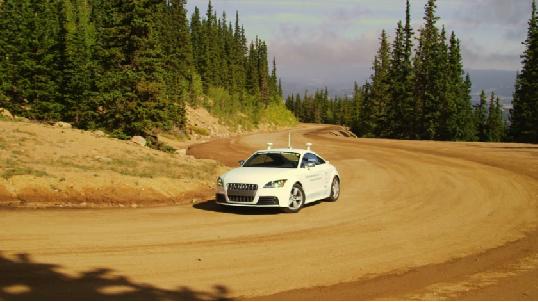Stanford’s Robot Car Tries for Peak Performance

Share
Sometime this year, Stanford plans on taking their driverless Audi TTS and using it to climb the 12.4 miles up Pike’s Peak. Now, if you’ve been following recent advances in robot driving you might not be too impressed. After all, a full five years ago Stanford successfully used a VW Touareg named Stanley to compete against dozens of cars through 132 miles of desert. Two years later, it came in 2nd place during the DARPA Urban challenge, where their car (nicknamed Junior) had to navigate a mock cityscape involving other cars and traffic signals. Comparatively, running solo, even through the 156 turns of the Pike’s Peak racecourse, seems to be a step back. But in this case, it’s not what Stanford is doing, but how they plan on doing it that’s impressive. According to the Volkswagen Automotive Innovations Lab (VAIL), the plan is to put the petal to the metal, drift through the turns, and race their way to the top.
Hitting high speeds will be a departure from what the Stanford team had to do in the past. Stanley never got above 38 mph in the desert, and high speeds were not an option in the Urban challenge. Instead, the challenges in those competitions mainly involved interpreting the information from the environment around the car. Going up Pike’s Peak will test the robotic car’s ability to interpret the information coming from the car itself, such as how its tires are gripping the road as it drifts through a turn.
Audi has already made progress in this area, setting an unofficial automated driving speed record of 130 mph. They also managed to get the car to do the pretty hard core maneuvering seen in the following video:
Be Part of the Future
Sign up to receive top stories about groundbreaking technologies and visionary thinkers from SingularityHub.


If they can perfect this, and actually race up the length of Pike’s Peak using rally driving techniques, it will be the closest anyone has yet come in developing a robot driver with a “feel” for the road.
Ostensibly, Stanford and VW are teaming up on this project to get experience pushing automated drive-by-wire techniques to their limit. This will help future computers to understand, in the split second before an accident, what maneuvers are in the range of possibility to avoid a collision. Personally however, I think they are doing it for a far more important reason- it’s just so damn cool.
Although we will faithfully report when a car can drive into a parking lot and park itself, a robot car kicking up dust clouds as it burns its way up Pike’s Peak is the kind of thing that makes the evening news. More coverage could alert people to how much progress we’ve made, in a world with adaptive cruise control and lane assist, towards realizing the dream of a self-driving car. It might also spark a robot competition to run the course in yet faster times. This would be great for two reasons. First, it might eventually give driving AI a “Deep Blue” moment if a team could beat the best human time for the racetrack. Second, with multiple teams pushing the limits on their way to the top, it would inevitably lead to spectacular crashes as cars fly off the thousand foot cliffs that line the course. All the fun of car wrecks without any of the guilt. All the while, of course, the fine-tuning of robotic driving would bring us closer to a world with no car wrecks at all.
[screen capture and video credit: BotJunkie]
Steven Wasick lands on the moon...
Related Articles

Your ChatGPT Habit Could Depend on Nuclear Power

AI Can Now Design Proteins and DNA. Scientists Warn We Need Biosecurity Rules Before It’s Too Late.

This Light-Powered AI Chip Is 100x Faster Than a Top Nvidia GPU
What we’re reading

